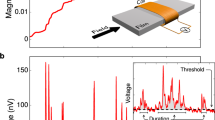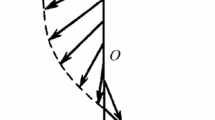We propose an analytic model for the quantitative assessment of a volume jump of domain walls, caused by the Barkhausen effect, under the action of a magnetic field accompanied by magnetoelastic acoustic emission. Dependences for the evaluation of its amplitudes are constructed. Initial data for the calculation of displacements with the proposed model are obtained. It is shown that the method of magnetoelastic acoustic emission is sensitive to the reconstruction of the domain structure of ferromagnets.
Similar content being viewed by others
References
V. M. Rudyak, “Barkhausen effect,” Usp. Fiz. Nauk, 111, No. 3, 429–462 (1970).
R. L. Sánchez, M. I. L. Pumarega, M. Armeite, et al., “ Barkhausen effect and acoustic emission in a metallic glass—preliminary results,” in: D. O. Thompson and D. E. Chimenti (editors), Review of Quantitative Nondestructive Evaluation, Vol. 23 (2004), pp. 1328–1335.
M. Shibata and K. Ono, “Magnetomechanical acoustic emission—a new method of nondestructive stress measurement,” in: NDT International, October (1981), pp. 227–234.
D. J. Buttle, C. B. Scruby, J. P. Yakubovics, and J. A. D. Briggs, “Magnetoacoustic and Barkhausen emission: their dependence on dislocations in iron,” Phil. Mag., 55, No. 6, 717–734 (1987).
J. Kameda and R. Ranjan, “Nondestructive evaluation of steels using acoustic and magnetic Barkhausen signals. I. Effect of carbide precipitation and hardness,” Acta Met., 35, No. 7, 1515–1526 (1987).
N. A. Glukhov and V. N. Kolmogorov, “Relation of parameters of acoustic noise in reversal magnetized structural materials,” Defektoskopiya, No. 2, 26–29 (1988).
K. Ono and M. Shibata, “Magnetomechanical acoustic emission of iron and steels,” Mater. Evaluation, 38, 55–61 (1980).
J. Kameda and R. Ranjan, “Nondestructive evaluation of steels using acoustic and magnetic Barkhausen signals. II. Effect of intergranular impurity segregation,” Acta Met., 35, No. 7, 1527–1531 (1987).
E. S. Gorkunov, V. A. Khamitov, O. A. Bertenev, et al., “Magnetoelastic acoustic emission in heat treated structural steels,” Defektoskopiya, No. 3, 3–9 (1987).
N. A. Glukhov, V. N. Kolmogorov, and B. I. Miletskii, “Investigation of acoustic noise in reversal magnetized structural materials,” Defektoskopiya, No. 9, 36–40 (1985).
M. Shibata, E. Kobajashi, and K. Ono, “The detection of longitudinal rail force via magnetomechanical acoustic emission,” J. Acoust. Emiss., 4, No. 4, 93–100 (1986).
G. V. Lomaev, V. A. Komarov, and V. I. Rubtsov, “Experimental investigation of the acoustic manifestation of the Barkhausen effect in structural steels,” in: Barkhausen Effect and its Use in Engineering [in Russian], Kalinin State University, Kalinin (1981), pp. 78–84.
Yu. G. Bezymyannyi, “Investigation of possibilities of the method of magnetoacoustic noise for the control of the fatigue of nickel,” in: Barkhausen Effect and its Use in Engineering [in Russian], Kalinin State University, Kalinin (1981), pp. 152–156.
R. Ranjan, D. C. Jiles, O. Buck, and R. V. Thompson, “Grain size measurement using magnetic and acoustic Barkhausen noise,” J. Appl. Phys., 61, No. 8, 3199-3201 (1987).
D. J. Buttle, J. P. Yakubovics, and J. A. D. Briggs, “Magnetoacoustic and Barkhausen emission from domain—wall interaction with precipitates in Incoloy 904,” Philos. Mag. A., 55, No. 6, 735–756 (1987).
V. D. Boltachev, I. V. Golovshchikova, A. E. Ermakov, and Yu. N. Dragoshanskii, “Barkhausen effect and magnetoacoustic emission in FeAl, FeCo, and FeSi alloys,” Fiz. Met. Metalloved., No. 12, 59–67 (1992).
K. Aki and P. G. Richards, Quantitative Seismology, Freeman, New York (1980).
J. D. Eshelby, “The determination of the elastic field of an ellipsoid inclusion and related problems,” Proc. Roy. Soc. London, A241, 379–396 (1957).
T. Kishi, “Acoustic emission source characterization and its application to microcracking,” Z. Metallk., 76, No. 7, 512–515 (1985).
M. A. Shibata, “A theoretical evaluation of acoustic emission signals. – The rise-time effect of dynamic force,” Mater. Eval., 42, No. 1, 107–120 (1984).
V. M. Rudyak, Switching Processes in Nonlinear Crystals [in Russian], Nauka, Moscow (1986).
S. Chikazumi, Physics of Ferromagnetism, Vol. 2: Magnetic Characteristics and Engineering Application, Shokabo, Tokyo (1984).
Author information
Authors and Affiliations
Corresponding author
Additional information
Translated from Fizyko-Khimichna Mekhanika Materialiv, Vol. 45, No. 3, pp. 67–75, May–June, 2009.
Rights and permissions
About this article
Cite this article
Skal’s’kyi, V.R., Serhienko, O.M., Mykhal’chuk, V.B. et al. Quantitative evaluation of Barkhausen jumps according to the signals of magnetoacoustic emission. Mater Sci 45, 399–408 (2009). https://doi.org/10.1007/s11003-009-9198-z
Received:
Published:
Issue Date:
DOI: https://doi.org/10.1007/s11003-009-9198-z




